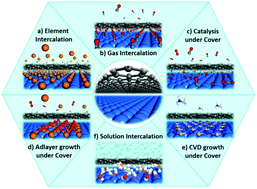Surface chemistry and catalysis confined under two-dimensional materials
Abstract
Two-dimensional (2D) materials are characterised by their strong intraplanar bonding but weak interplanar interaction. Interfaces between neighboring 2D layers or between 2D overlayers and substrate surfaces provide intriguing confined spaces for chemical processes, which have stimulated a new area of “chemistry under 2D cover”. In particular, well-defined 2D material overlayers such as graphene, hexagonal boron nitride, and transition metal dichalcogenides have been deposited on solid surfaces, which can be used as model systems to understand the new chemistry. In the present review, we first show that many atoms and molecules can intercalate ultrathin 2D materials supported on solid surfaces and the space under the 2D overlayers has been regarded as a 2D nanocontainer. Moreover, chemical reactions such as catalytic reactions, surface adlayer growth, chemical vapor deposition, and electrochemical reactions occur in the 2D confined spaces, which further act as 2D nanoreactors. It has been demonstrated that surface chemistry and catalysis are strongly modulated by the 2D covers, resulting in weakened molecule adsorption and enhanced surface reactions. Finally, we conclude that the confinement effect of the 2D cover leads to new chemistry in a small space, such as “catalysis under cover” and “electrochemistry under cover”. These new concepts enable us to design advanced nanocatalysts encapsulated with 2D material shells which may present improved performance in many important processes of heterogeneous catalysis, electrochemistry, and energy conversion.

- This article is part of the themed collection: Fundamental insights into interfacial catalysis


 Please wait while we load your content...
Please wait while we load your content...